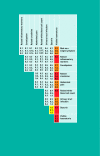Clinical features of bladder cancer in primary care
- PMID: 22947580
- PMCID: PMC3426598
- DOI: 10.3399/bjgp12X654560
Clinical features of bladder cancer in primary care
Erratum in
- Br J Gen Pract. 2014 Mar;64(620):126
Abstract
Background: Bladder cancer accounts for over 150,000 deaths worldwide. No screening is available, so diagnosis depends on investigations of symptoms. Of these, only visible haematuria has been studied in primary care.
Aim: To identify and quantify the features of bladder cancer in primary care.
Design and setting: Case-control study, using electronic medical records from UK primary care.
Method: Participants were 4915 patients aged ≥40 years, diagnosed with bladder cancer January 2000 to December 2009, and 21,718 age, sex, and practice-matched controls, were selected from the General Practice Research Database, UK. All clinical features independently associated with bladder cancer using conditional logistic regression were identified, and their positive predictive values for bladder cancer, singly and in combination, were estimated.
Results: Cases consulted their GP more frequently than controls before diagnosis: median 15 consultations (interquartile range 9-22) versus 8 (4-15): P<0.001. Seven features were independently associated with bladder cancer: visible haematuria, odds ratio 34 (95% confidence interval [CI] = 29 to 41), dysuria 4.1 (95% CI = 3.4 to 5.0), urinary tract infection 2.2 (95% CI = 2.0 to 2.5), raised white blood cell count 2.1 (95% CI = 1.6 to 2.8), abdominal pain 2.0 (95% CI = 1.6 to 2.4), constipation 1.5 (95% CI = 1.2 to 1.9), raised inflammatory markers 1.5 (95% CI = 1.2 to 1.9), and raised creatinine 1.3 (95% CI = 1.2 to 1.4). The positive predictive value for visible haematuria in patients aged ≥60 years was PPV of 2.6% (95% CI = 2.2 to 3.2).
Conclusion: Visible haematuria is the commonest and most powerful predictor of bladder cancer in primary care, and warrants investigation. Most other previously reported features of bladder cancer were associated with the disease, but with low predictive values. There is a need for improved diagnostic methods, for those patients whose bladder cancer presents without visible haematuria.
Figures
Comment in
-
Predicting risk of bladder cancer in the UK.Br J Gen Pract. 2012 Nov;62(604):570-1. doi: 10.3399/bjgp12X658160. Br J Gen Pract. 2012. PMID: 23211155 Free PMC article. No abstract available.
Similar articles
-
Non-visible versus visible haematuria and bladder cancer risk: a study of electronic records in primary care.Br J Gen Pract. 2014 Sep;64(626):e584-9. doi: 10.3399/bjgp14X681409. Br J Gen Pract. 2014. PMID: 25179073 Free PMC article.
-
Clinical features of kidney cancer in primary care: a case-control study using primary care records.Br J Gen Pract. 2013 Apr;63(609):e250-5. doi: 10.3399/bjgp13X665215. Br J Gen Pract. 2013. PMID: 23540481 Free PMC article.
-
Evaluation of diagnostic strategies for bladder cancer using computed tomography (CT) urography, flexible cystoscopy and voided urine cytology: results for 778 patients from a hospital haematuria clinic.BJU Int. 2012 Jul;110(1):84-94. doi: 10.1111/j.1464-410X.2011.10664.x. Epub 2011 Nov 28. BJU Int. 2012. PMID: 22122739
-
The Diagnostic Accuracy of Cystoscopy for Detecting Bladder Cancer in Adults Presenting with Haematuria: A Systematic Review from the European Association of Urology Guidelines Office.Eur Urol Focus. 2024 Jan;10(1):115-122. doi: 10.1016/j.euf.2023.08.002. Epub 2023 Aug 24. Eur Urol Focus. 2024. PMID: 37633791
-
Non-visible haematuria for the Detection of Bladder, Upper Tract, and Kidney Cancer: An Updated Systematic Review and Meta-analysis.Eur Urol. 2020 May;77(5):583-598. doi: 10.1016/j.eururo.2019.10.010. Epub 2019 Nov 30. Eur Urol. 2020. PMID: 31791622
Cited by
-
Assessment of cancer risk in men and women.Br J Gen Pract. 2013 Jan;63(606):4-5. doi: 10.3399/bjgp13X660607. Br J Gen Pract. 2013. PMID: 23336445 Free PMC article. No abstract available.
-
Quantifying the impact of pre-existing conditions on the stage of oesophagogastric cancer at diagnosis: a primary care cohort study using electronic medical records.Fam Pract. 2021 Jul 28;38(4):425-431. doi: 10.1093/fampra/cmaa132. Fam Pract. 2021. PMID: 33346832 Free PMC article.
-
Conceptual Framework to Guide Early Diagnosis Programs for Symptomatic Cancer as Part of Global Cancer Control.JCO Glob Oncol. 2021 Jan;7:35-45. doi: 10.1200/GO.20.00310. JCO Glob Oncol. 2021. PMID: 33405957 Free PMC article.
-
Carcinoma in situ within the bladder trigone with an isolated metastasis to the prostate without involvement of prostatic urethra: a unique case report.BMC Urol. 2024 Jun 15;24(1):127. doi: 10.1186/s12894-024-01516-6. BMC Urol. 2024. PMID: 38879527 Free PMC article.
-
Understanding symptom contribution to sex inequality in bladder and renal cancer stage at diagnosis.BJUI Compass. 2024 Apr 19;5(7):691-698. doi: 10.1002/bco2.360. eCollection 2024 Jul. BJUI Compass. 2024. PMID: 39022664 Free PMC article.
References
-
- Jemal A, Bray F, Center MM, et al. Global cancer statistics. CA Cancer J Clin. 2011;61(2):69–90. - PubMed
-
- Mowatt G, Zhu S, Kilonzo M, et al. Systematic review of the clinical effectiveness and cost-effectiveness of photodynamic diagnosis and urine biomarkers (FISH, ImmunoCyt, NMP22) and cytology for the detection and follow-up of bladder cancer. Health Technol Assess. 2010;14(4):1–131. - PubMed
-
- National Audit Office. Delivering the cancer reform strategy. London: The Stationery Office; 2010.
-
- Wallace D, Bryan R, Dunn J, et al. Delay and survival in bladder cancer. BJU Int. 2002;89(9):868–878. - PubMed
-
- Liedberg F, Anderson H, Mansson A, Mansson W. Diagnostic delay and prognosis in invasive bladder cancer. Scand J Urol Nephrol. 2003;37(5):396–400. - PubMed
Publication types
MeSH terms
Grants and funding
LinkOut - more resources
Full Text Sources
Other Literature Sources
Medical


